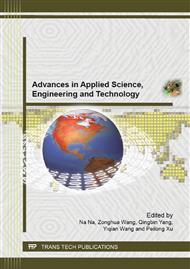p.871
p.875
p.879
p.883
p.887
p.891
p.895
p.903
p.907
Study on the Degumming Process of Abelmoschus Manihot (L.) Medik by Microwave-Assisted Treatment
Abstract:
In this study, aiming at the characteristics of Abelmoschus manihot (L.) bast lignin content is high and degumming difficulty, it introduces a new type of degumming methods. Microwave-assisted treatment was used in the degumming process of Abelmoschus manihot (L.) Medik. The effect of NaOH concentration, microwave-assisted treatment time and temperature on the residual gum content in Abelmoschus manihot (L.) Medik fibers were investigated. The result showed that the optimal conditions by microwave-assisted treatment were 50min of processing time,10g/L of NaOH concentration and 95°C of temperature when the residual gum content could reach to 0.96%. Compared with the traditional process, this method significantly shortened the time from 90-240min to 50min. Developed a highly efficient, low energy consumption degumming process, and the Abelmoschus manihot (L.) fiber after the degumming process was be applied to the development and utilization of textile products.
Info:
Periodical:
Pages:
887-890
Citation:
Online since:
June 2013
Authors:
Keywords:
Price:
Сopyright:
© 2013 Trans Tech Publications Ltd. All Rights Reserved
Share:
Citation:


